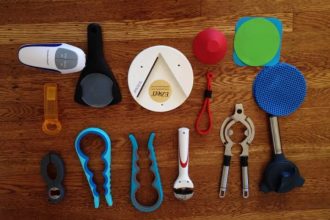The most important utensil in the kitchen is arguably the knife. Thanks to its widespread availability, affordability, and versatility, nearly every dish can be accompanied by it. Knife-wielding chefs have been known to produce masterpieces in the kitchen, so why not learn more about your knives? If you’re planning to buy a set of knives, it’s helpful to know which types of knives you’ll need. This guide will give you an introduction to the world of kitchen knives and outline knife types that are commonly available on the market today.
The Different Types Of Kitchen Knives
1. Chef’s Knife
This is a multipurpose knife that can be used for a wide array of different kitchen tasks. It usually has an 8-inch blade, which is considered to be the ideal size for most home users. The best chef’s knives are weighted to balance well in the hand, so they feel light and nimble. This type of knife is good for cutting vegetables, meats, fish, poultry, fruit, and pretty much anything you can think of.
- Blade Type: The blade on this knife has a slight curve that makes it ideal for rocking up and down. This motion is useful when you’re cutting foods that require a lot of repetitive action, such as meats and vegetables.
- Handle Type: The handle on a chef’s knife is usually made from molded plastic or polypropylene. That being said, there are also some higher-end knives on the market with ergonomic handles that can reduce fatigue.
2. Boning Knife
Boning knives are most commonly used to debone the meat, although they can also be helpful when preparing seafood or poultry. This type of knife has a narrow, flexible blade that’s usually between 5-6 inches long. Thanks to its sharp, slender shape, the blade on this knife is extremely useful for removing skin and excess fat.
- Blade Type: This type of knife has a blade-like straight, thin metal wire with an angled tip. The flexible design allows the blade to bend in order to navigate around bones, joints, and other challenging areas.
- Handle Type: If you plan on using your boning knife for fish, poultry, or seafood, you might want to consider purchasing a boning knife with a soft grip. This will help prevent unsightly stains on the handle that are common with this type of blade.
3. Chef’s / Utility Knife
Combining the functions of a chef’s knife and a paring knife, the utility knife is an all-purpose kitchen blade that can handle many different tasks. It’s larger than a paring knife, with a slightly curved blade that makes it ideal for dicing as well as some other activities such as julienning or chopping vegetables.
- Blade Type: The blade on these knives can be serrated or smooth. It’s usually between 6-8 inches long, making it quite useful for dicing potatoes, onions, carrots, celery, and other vegetables.
- Handle Type: This type of knife is designed to be versatile enough for everyday tasks in the kitchen. To keep up with this requirement, it’s usually equipped with a rubber or polypropylene handle.
4. Paring Knife
This is an extremely useful knife for all aspects of food preparation, especially dicing vegetables and fruits. A paring knife has a blade that’s about 2-4 inches long. While some people believe it’s meant for peeling, its small size makes it difficult to use the knife in this way.
- Blade Type: The sharp tip of a paring knife allows you to carve out blemishes and imperfections from fruits and vegetables. It also gives you more control when slicing strawberries or peeling apples.
- Handle Type: This type of knife has a handle that is usually made from polypropylene or hard plastic.
5. Slicing Knife
While these knives are most commonly seen in the deli or meat department, they can also be used at home to prepare large amounts of food for cooking, serving, or storage. Slicing knives have blades that range between 8 and 12 inches long and can be straight or slightly curved.
- Blade Type: This sort of knife has a thin blade with a sharp point that’s useful for cutting meats and vegetables into even slices. Some slicing knives come equipped with holes in the blade which prevents excess liquids from accumulating on the flat side of the blade.
- Handle Type: The easiest way to tell if you’re holding a slicing knife is by checking the size. These knives are long and thin, making them quite easy to handle, even for people with small hands.
6. Butcher’s Knife
Butcher’s knives are designed specifically for use in meat preparation. The blade on this type of knife can range between 5-14 inches long, depending on what your needs are at the time. This sort of knife is usually equipped with either an extremely sharp straight edge or a curved edge like that found on a scimitar (the curved blade was initially used for skinning animals).
- Blade Type: Butcher’s knives can be sharpened with both flat edges as well as hollow grinds. These knives are quite durable and can handle the tough demands of meat preparation.
- Handle Type: Butcher’s knives are commonly made in either a fixed or folding design, making them safer to store when not being used. The blade itself is usually equipped with a plastic or wooden handle.
7. Chef’s Steak Knife
Designed to cut through steak and other tough meats, chef’s steak knives have a blade that is generally between 5 – 7 inches long. They are very sharp and can be used for cutting resealable plastic or butcher’s twine as well as meat. Chef’s steak knives usually come with a wooden handle that is either dark brown or black in color.
- Blade Type: These knives have a single-sided serrated edge which allows you to cut through even the toughest meats using the least amount of pressure possible on the blade itself. The serrated edge also makes it easy to saw through large cuts of meat.
- Handle Type: These knives are typically designed with wooden handles that are easy to hold onto while cutting, even while wearing gloves or using a carving fork in conjunction with the knife.
8. Chippers (Sausage Knife)
Chippers can also be referred to as sausage knives, depending on what you’re cooking up for dinner that night (or morning). This type of knife is equipped with a blade that ranges between 4-8 inches long and has small serrations along one side of the blade’s edge. Chippers are used when making wieners, bratwurst, hot dogs, and other types of sausages.
- Blade Type: The blade on this type of knife is made from either high carbon stainless steel or ceramic, depending on the manufacturer. Ceramic blades are ultra-sharp but also very fragile. They should never be used to cut anything other than sausage because they could break if accidentally dropped on the floor.
- Handle Type: These knives have a handle that fits comfortably in your hand, allowing you to hold onto it while making sausage links. Chippers come with wooden handles that are usually dark brown or black in color.
9. Santoku Knife
Specifically designed for preparing meat, this sort of knife is very popular in Japan where it originated. The blade on a santoku knife is usually between 5 – 7 inches long and has a wide front section but gets progressively narrower towards the back end of the blade itself. It can be used to slice, dice, or even mince your favorite raw meats.
- Blade Type: This type of knife has a number of different patterns along its blade which help to keep food from sticking while cutting. There’s also serration on one side of the blade that helps make slicing easier when working with vegetables or smaller cuts of meat. Santoku knives are typically made from either high carbon stainless steel or ceramic, depending on the manufacturer you choose to go with.
- Handle Type: These knives come with a handle that is designed to fit comfortably in your hand. The dark brown or black wooden handle allows you to grip the knife more easily and makes its movements easier to control.
10. Paring Knife
The smallest of all kitchen knives, paring knives usually have blade lengths between 2 – 4 inches long and are used for peeling apples, potatoes, and other vegetables. They can also be used to make small cuts including truffles, shallots, and julienne strips of carrots and cucumbers for salads.
- Blade Type: Paring knives have thin blades made from high carbon stainless steel so they stay sharp even after frequent use over time. Instead of a serrated edge for cutting, the blade itself is always very smooth.
- Handle Type: These knives have a handle that fits nicely in your hand which allows you to grip it more easily when cutting with it. The wooden handle can be dark brown or black in color.
Types Of Kitchen Knives FAQs
1. What is a kitchen knife?
A kitchen knife is a long-bladed implement used in the preparation of food, such as slicing meat and chopping vegetables. The two main types of kitchen knives are paring and carving knives. These all have different shaped blades with various uses to make your time in the kitchen easier and more efficient.
2. How do you clean a serrated blade?
It can be difficult to clean a serrated blade when it has become very dirty; however, there are several methods that can be used to get it back into pristine condition. First, fill up half an inch of sink with warm water then add in some dish soap for cleaning power. Next, add 2 tablespoons of baking soda into the sink. Using the fingernail side, slowly scrape off large food particles. Once clean, rinse with clean water and dry thoroughly to prevent rusting.
3. What is the best material for a kitchen knife handle?
Wooden handles are traditional to most kitchen knives; therefore, they’re commonly found on these types of utensils. They often have an ergonomic design which makes it easier to hold onto them for extended periods of time without experiencing any discomfort or cramping in your hands or fingers. Kitchen knives that don’t have wooden handles will usually have either plastic or metal ones instead. Plastic can be slippery when wet whereas metal can get cold during winter seasons; therefore, wooden handles are recommended as they’re easy to grip onto.
4. How can I sharpen my kitchen knife?
There are several ways to do this which include purchasing a sharpening stone or honing rod, using sandpaper or applying lemon juice to the blade. To easily sharpen your kitchen knife with sandpaper, use 80 grit paper and slide your fingernail across it in one direction to remove small nicks and burrs before switching directions to polish it out. For even better results, wipe down the blade often with oil-free cooking spray to keep it lubricated while you’re smoothing out the metal.
5. What is a bread knife?
A bread knife has a long serrated blade that’s usually 8 inches long so you can easily slice through thick pieces of bread without squashing it. It can also be used to cut through other foods that are similar in inconsistency, such as cakes and pastries.
6. What is a boning knife?
A boning knife is sometimes referred to as a fillet knife or breaking knife because it’s specially designed for removing bones from meat with ease while keeping the flesh intact. It has a long, narrow blade that tapers into a point which allows you to slide it underneath large cuts of meat so the bone comes out cleanly with minimal loss. Other kitchen knives may have difficulty doing this efficiently, due to their wide widths which smash food instead of cutting them cleanly.
7. Why should I buy Japanese kitchen knives?
Japanese kitchen knives are known for their superior quality and sharpness compared to other types of bladed utensils on the market today. This is due to them being made from very hard steel which makes it easier to maintain an exceedingly sharp edge – one that can easily be seen with the naked eye. Other knife manufacturers don’t use such high grades of metal for their blades and end up having to coat them with a resin to make the edge appear shiny and sharp.
8. How should I care for my kitchen knives?
To prevent damage or scratches, always make sure to put your knife back in its designated spot on your magnetic strip or wooden block when you’re done using it. This will ensure that you don’t risk dulling the blade by running it across other utensils in the drawer like teaspoons and forks; therefore, making it last longer without needing to be replaced as often. You can also increase the lifespan of your knives by avoiding putting them through the dishwasher because they can end up with chips on their edges which makes them even blunter than before.
Conclusion
The kitchen is the heart of every home. It’s where families gather to cook, eat, and enjoy time together around a dinner table. This means that it’s important for your kitchen to be stocked with the best tools possible because you can’t buy happiness in a store but you CAN make it at home! If you are interested in buying new knives or replacing old ones, take some time to read our blog post on how to know what type of knife set will work best for your needs. We hope this information helps guide you when choosing which knives suit your culinary style so that all who enter into your domain feel welcomed by an inviting atmosphere!







